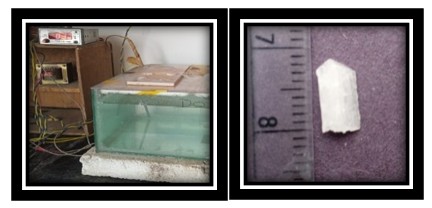Growth and Characterization of Glycine single crystal by addition of Aluminum Chloride
DOI:
https://doi.org/10.61343/jcm.v3i02.150Keywords:
UV-VIS, FTIR, XRD, solution growth technique, single crystalAbstract
In this work, growth of single glycine crystal with the addition of aluminium chloride, using a slow evaporation process. In this study, glycine is doped into 0.8M% of aluminium chloride. The semi-organic single crystal glycine doped with aluminium chloride has been produced at a constant temperature of 36°C. Powder X-ray diffraction (XRD) is used for verifying the crystalline nature and alpha phase of doped glycine that contains aluminium chloride. The thermal stability and thermal decomposition of the sample was studied by thermo gravimetric/differential thermo analytical method. Using the UV-absorption spectrum, the optical transmittance window and lower cutoff wavelength have been examined.
References
R. Rameshbabu, N. Vijayan, R. Gopalkrishnan, P. Ramasay, cryst. Res. Technol 41 (2006) 405.
M. Senthil Pandian, P. Ramasamy, J. Cryst. Growth 2008; 310: 2563-8.
S. Dhanuskodi, A. P. Jeyakumari, S. Manivannan. J. Cryst. Growth 282(2005)72.
P. Langen, S. A. Mason, D. Myles, B. P. Schoenborn Acta cryst 358(2002)728.
B. N. Moolya, A. Jayarama, M. R. Sureshkumar, S. M. Dharmaprakash, J. Cryst. Growth 280 (2005) 581.
M. Drozdowski et al. Spectrosc. Acta A 42 (7) (2001) 833.
Michel Fleck et al. Acta crystalloger. C 60 (6) (2004) 291.
R. Shanmugadivu, G. Ravi, A. A. Nixon, J. Phys. Chem. solids 67(2006)1858
S. Anbu Chudar Azhagan, S.Ganesan, Arabian Journal of Chemistry (2013).
G. S. Kell, (1977). Journal of physical and chemical reference data,6(4),1109-1131.
K. Srinivasan, J. Arumugan, opt. mater.30 (2007) 40.

Downloads
Published
How to Cite
License
Copyright (c) 2025 U. B. Tagade, N. S. Meshram

This work is licensed under a Creative Commons Attribution 4.0 International License.
Copyright© by the author(s). Published by journal of Condensed Matter. This is an open access article distributed under the terms of the Creative Commons Attribution (CC BY) license (https://creativecommons.org/licenses/by/4.0/), which permits unrestricted use, distribution, and reproduction in any medium, provided the original author(s) and source are credited.









